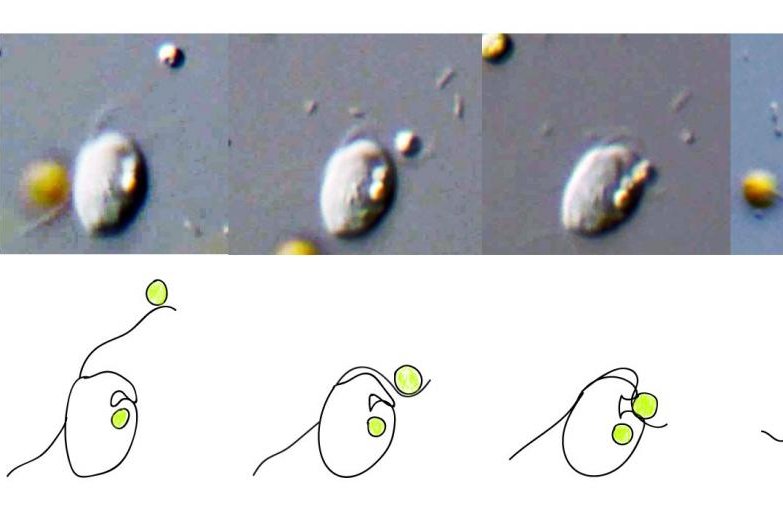The microscopic images show a Roombia cell eating an algal cell called Mantionella. Photo by AMNH/J. Burns
Feb. 20 (UPI) -- Scientists have designed a new model to identify which organisms are capable of consuming other cells through a process called phagocytosis.
The research, detailed this week in the journal Nature Ecology and Evolution, could help scientists more accurately simulate the evolution of early complex lifeforms.
The earliest life forms on Earth were made up of prokaryotes, simple, single-celled organisms -- bacteria and archaea. More complex lifeforms, including animals, plants, fungi and protists, feature eukaryotic cells, larger cells with a variety of specialized components, including energy-producing organelles called mitochondria.
But scientists have struggled to explain how eukaryotic cells evolved from prokaryotic cells. Some suggest the transformation was made possible by phagocytosis.
"Phagocytosis is a major mechanism of nutritional uptake in many single-celled organisms, and it's vital to immune defenses in a number of living things, including humans," Eunsoo Kim, an associate curator of invertebrate zoology at the American Museum of Natural History, said in a news release.
"But lesser known is the idea that phagocytosis dates back some 2 to 3 billion years and played a role in those symbiotic associations that likely started the cascading evolution toward the more diverse and complex life we see on the planet today. Our research provides some hints as to how phagocytosis first arose."
Scientists have previously hypothesized that the mitochondria and the first eukaryotes evolved after a prokaryote "engulfed" another prokaryote between 2 and 3 billion years ago. No modern prokaryotes, however, have been observed performing phagocytosis.
To determine which types of cells are capable of phagocytosis, scientists developed a model to survey their genetic patterns.
"There's no single set of genes that are strongly predictive of phagocytosis because it's a very complicated process that can involve more than 1,000 genes, and those genes can greatly vary from species to species," said John Burns, a research scientist in the AMNH's Sackler Institute for Comparative Genomics. "But as we started looking at the genomes of more and more eukaryotes, a genetic pattern emerged, and it exists across diversity, even though it's slightly different in each species."
Researchers used the pattern to develop a predictive model, a model to determine whether an organism is likely to eat, or engulf, other cells or not.
Because many eukaryotes, including blue green algae, only perform phagocytosis under very specific conditions, it can be hard to tell if an organism is capable of eating other cells or not. The new model offers scientists a more efficient way to survey and organize groups of organisms.
To test their model, scientists applied it to an Asgard archaea, a group of "eukaryote-like" single-celled microorganisms. Some scientists think the microbes are the descendants of the microbes that first merged with bacterial cells and evolved mitochondria.
The latest analysis showed Asgard archaea are most likely incapable of phagocytosis. Scientists also explored the genetic lineage of archaea and bacteria and found neither possess the genes needed for phagocytosis.
How the first mitochondria and eukaryotes emerged remains an open question.
"When you tease apart the components of these predictive genes, some have roots in archaea, some have roots in bacteria, and some are only unique to eukaryotes," Kim said. "Our data are consistent with the hypothesis that our cells are a chimera of archaeal and bacterial components, and that the process of phagocytosis arose only after that combination took place. We still have a lot of work to do in this field."















